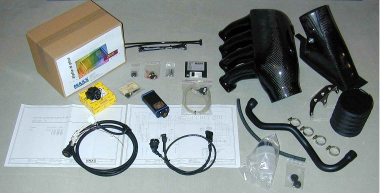.Alpha-N Explanation
.Courtesy of Gustave
Stroes

Components of a typical Alpha-N kit......................................................................
Gruppe,
I know many folks on this board understand quite well what Alpha-N is, but this is for those who don't understand it. I remember how that felt, so I will offer my version of an explanation.
An engine management computer, regardless of how sophisticated or crude, really only controls two parameters. The ignition timing and the fuel delivery. The computer (DME or some aftermarket brand) uses an array of input sensors to try and determine what state the engine is in at any point in time. Is it loafing along on the freeway at low rpm, or at max throttle climbing a hill at high rpm? Is it hot outside so that the air is thin? Or is it butt cold and the air is real dense?
The list goes on, but the goal of the computer at all times is to sample its input sensors and then determine the appropriate output signals for ignition timing and fuel delivery (usually this determines how long the fuel injectors fire, which is called the pulse width, but it can also entail "when" to fire the injectors if the injection is sequential).
The two most important things that the computer wants to know in order to determine spark and fuel are: 1) engine load, and 2) engine rpm.
Engine rpm is easily determined from a crank sensor. But engine load is a little more tricky. The best parameter to use in determining engine load is the MASS of air entering the engine at any time. If you can measure the mass of air directly then you are well off. Current BMW's do just this with what is called a MAF sensor, or mass air flow sensor. This is usually some type of heated wire or film, which is cooled by the air flowing over it. In order to keep the wire at the same temperature additional electrical current must be provided, and the measure of this extra current gives a fairly direct indication of the mass air flow.Our E30 M3's used a similar system, although it measures the VOLUME of air flowing into the engine. The sensor is called an AFM, which stands for air flow meter. The volumetric flow is determined by how far a flapper (or barn door) is pushed aside by the incoming air. The flapper is connected to a potentiometer (variable resistor, POT, wiper, there are many names). But for the computer to know how much fuel to mix with the air it needs to know how many molecules of air are coming in, and that can only be determined by knowing the MASS of the air, not just the volume. So, we need to combine the AFM air volume signal with an air TEMPERATURE measurement Then the air mass can be determined. So we are ok.
Note that in both cases the computer has some hard data on how much air is entering the engine, so if you improve engine breathing (header cams etc...), the basic code will still sort of work as the computer is aware of the additional air. It's not perfect, but it works ok most of the time for changes that are not too drastically different than the baseline.
Alpha-N is different. Here there is no direct measurement of either the mass of air, nor the volume of air entering the engine. That way any possible obstruction from either a MAF sensor or AFM sensor in the intake path is removed. The air can flow right into the engine unobstructed. So how does the computer know what to do? It still has rpm info from the crank, but it can't measure the mass of air coming into the engine for fuel mixture determination?
The answer, in a crude sense, is that you "train" the computer what to do in a given situation (on the dyno). For every possible combination of throttle position and rpm, the tuner determines the appropriate ignition timing and fuel delivery to yield max power but not incur detonation. The computer just remembers all this (in the form of maps which are stored on a chip), and when it sees a certain combination of rpm and throttle position in the field, it just says "what did they tell me to do in this situation?" and does that.
So now throttle position and RPM are the two dominant input parameters to the engine computer. This is where the Alpha-N name derives from. Alpha for the angle of the throttle plates and N for RPM.
Now if you have an Alpha-N system, and add a hotter set of cams that allow more air into the engine, but you do not reprogram the Alpha-N computer, then the computer has no knowledge of the extra air now entering the engine and it just gives the fuel and spark that it was told was appropriate for the milder set of cams. One can see how this could be a problem. Your mixture especially, but also your ignition timing will be way off. If your mixture goes lean you can potentially damage the engine. That is why folks say that an Alpha-N system needs to be retuned everytime you make a change to the engine. The computer is "flying blind" to some extent, although it does at least have an air temp sensor and a barro sensor to try to compensate for density changes in the air due to temperature and elevation.
I have oversimplified some subjects to make it easier to understand, and as usual there is probably more that I did not say than that I did say about Alpha-N, but hopefully that gets some folks a little closer to understanding it.
FWIW,
Gustave